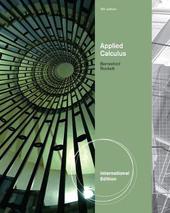
|
Applied Calculus, International Edition
Paperback
Main Details
| Title |
Applied Calculus, International Edition
|
| Authors and Contributors |
By (author) Geoffrey C. Berresford
|
|
By (author) Andrew Rockett
|
| Physical Properties |
| Format:Paperback | | Pages:912 | | Dimensions(mm): Height 253,Width 203 |
|
| Category/Genre | Business mathematics and systems
Applied mathematics |
|---|
| ISBN/Barcode |
9781133103936
|
| Classifications | Dewey:515 |
|---|
| Audience | | Tertiary Education (US: College) | |
|---|
| Edition |
International Edition
|
|
Publishing Details |
| Publisher |
Cengage Learning, Inc
|
| Imprint |
Brooks/Cole
|
| Publication Date |
21 March 2012 |
| Publication Country |
United States
|
Description
This text uses intriguing real-world applications to engage readers' interest and show them the practical side of calculus. The book's many applications are related to finance, business, and such general-interest topics as the growing population of Africa, the composition of the Supreme Court, water shortage, the fastest pitch in baseball, and pollution and the depletion of natural resources. The Sixth Edition maintains the hallmark features that have made APPLIED CALCULUS, International Edition so popular: contemporary and interesting applications; careful and effective use of technology, including graphing calculator and spreadsheet coverage; constant pedagogical reinforcement through section summaries, chapter summaries, annotated examples, and extra practice problems; Just-in-Time algebra review material; and a variety of exercises that allow readers to practice and hone their problem-solving skills.
Author Biography
After completing his Ph.D. at Stony Brook University, Dr. Rockett joined the mathematics faculty at C.W. Post and began his collaborations with Dr. Berresford. His book with Peter Szusz on CONTINUED FRACTIONS (1992) was hailed by Ivan Niven as "an outstanding addition to the literature of mathematics," and he served the Kappa Mu Epsilon mathematics honor society as editor of the mathematics journal The Pentagon from 1989 to 1995. Dr. Rockett serves as a reviewer for several journals, including Mathematical Reviews for the American Mathematical Society. Dr. Berresford received his Ph.D. from the Courant Institute of Mathematical Sciences at New York University and taught at the State University of New York at Purchase before joining the faculty at the C.W. Post campus of Long Island University. Besides co-authoring four textbooks with Dr. Rockett, he has published papers in differential equations, linear programming, logic, and probability, and has received several teaching awards and the Distinguished Service Award from The Metropolitan New York Section of the Mathematical Association of America.
Reviews1. FUNCTIONS. Real Numbers, Inequalities, and Lines. Exponents. Functions: Linear and Quadratic. Functions: Polynomial, Rational, and Exponential. 2. DERIVATIVES AND THEIR USES. Limits and Continuity. Rates of Change, Slopes, and Derivatives. Some Differentiation Formulas. The Product and Quotient Rules. Higher-Order Derivatives. The Chain Rule and the Generalized Power Rule. Nondifferentiable Functions. 3. FURTHER APPLICATIONS OF DERIVATIVES. Graphing Using the First Derivative. Graphing Using the First and Second Derivatives. Optimization. Further Applications of Optimization. Optimizing Lot Size and Harvest Size. Implicit Differentiation and Related Rates. 4. EXPONENTIAL AND LOGARITHMIC FUNCTIONS. Exponential Functions. Logarithmic Functions. Differentiation of Logarithmic and Exponential Functions. Two Applications to Economics: Relative Rates and Elasticity of Demand. 5. INTEGRATION AND ITS APPLICATIONS. Antiderivatives and Indefinite Integrals. Integration Using Logarithmic and Exponential Functions. Definite Integrals and Areas. Further Applications of Definite Integrals: Average Value and Area Between Curves. Two Applications to Economics: Consumers' Surplus and Income Distribution. Integration by Substitution. 6. INTEGRATION TECHNIQUES. Integration by Parts. Integration Using Tables. Improper Integrals. Numerical Integration. 7. CALCULUS OF SEVERAL VARIABLES. Functions of Several Variables. Partial Derivatives. Optimizing Functions of Several Variables. Least Squares. Lagrange Multipliers and Constrained Optimization. Total Differentials and Approximate Changes. Multiple Integrals. 8. TRIGONOMETRIC FUNCTIONS. Triangles, Angles, and Radian Measure. Sine and Cosine Functions. Derivatives of Sine and Cosine Functions. Integrals of Sine and Cosine Functions. Other Trigonometric Functions. 9. DIFFERENTIAL EQUATIONS. Separation of Variables. Further Applications of Differential Equations: Three Models of Growth. First-Order Linear Differential Equations. Approximate Solutions of Differential Equations: Euler's Method. 10. SEQUENCES AND SERIES. Geometric Series. Taylor Polynomials. Taylor Series. Newton's Method. 11. PROBAILITY. Discrete Probability. Continuous Probability. Uniform and Exponential Random Variables. Normal Random Variables.
|